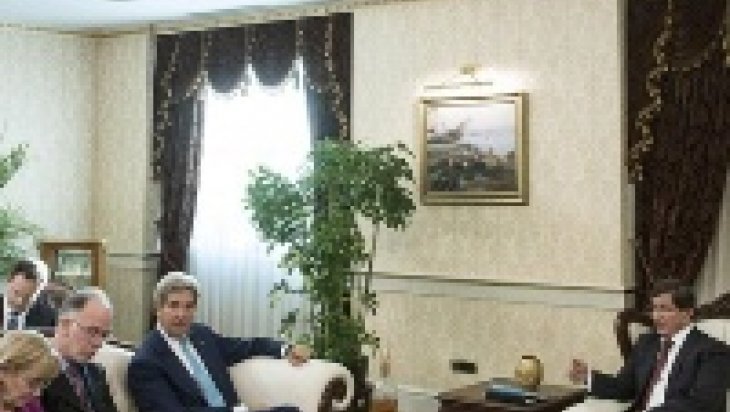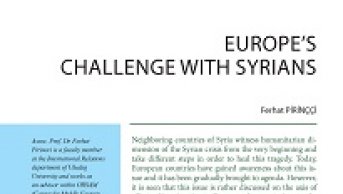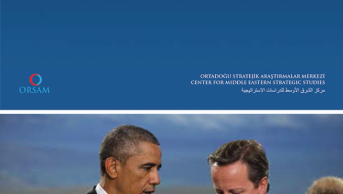The Syria Aspect of the War against ISIS and Turkey’s Concerns

U.S. President Barack Obama declared his plan against the Islamic State of Iraq and Syria (ISIS) on 10 September 2014. The plan, in general, consists of four elements: aerial strikes against ISIS targets, supporting local forces, preventing ISIS’s recruitment and finances, and continuing the humanitarian assistance to the region. According to the plan, an anti-ISIS coalition has been formed and the implementation of the plan has started. The aerial strikes in Iraq, which had begun before the plan was announced, were extended to Syria on September 23. However the conditions in Iraq and Syria, which involve the implementation of strategy, are different from each other.
There are a central government and relatively strong local partners in Iraq, which support the coalitions’ fight against ISIS. In Syria, the U.S. and its allies’ cooperation with Bashar Assad administration is an ill-omened issue, while the opposition that is available for cooperation is weak. Even if the US undertakes an overt or covert cooperation with the Assad regime, its consequences may negatively affect the local and regional dynamics.
The Gaps of the ISIS Strategy in Syria
The implementation of the Syria phase of the U.S. plan against ISIS reveals several problems. Aerial strikes are the easiest element of the strategy. Unless the aerial strikes are supported by other moves, the strategy will be doomed to failure. Thus, there are numerous doubts on the issue that what will coalition gain and ISIS lose from the airstrikes in Syria.
ISIS does not only consists of troops deployed in military bases. Many ISIS militants live alongside local people in the areas under its control. Therefore, hitting ISIS convoys and military units that are detached from civilians may cause some damage to ISIS, however will not end its control on the ground. Extending the aerial strikes in Syria will inevitably increase the civilian casualties. It will bring forth local and regional reactions against the coalition and trigger new refugee influx.
The success of the aerial strikes against ISIS depends on the cooperation with the local forces on the ground. However the so-called “moderate” opposition in Syria is weak and disorganized. The disorder among the “moderate” opposition evokes doubts about the efficiency of cooperation against ISIS. Moreover, the Syrian opposition regards the fight against ISIS not as a goal but as an obstacle that needs to be overcome in the way to the goal. In sum, unless they are given a guarantee for support against the Assad regime, the Syrian opposition’s contribution for the coalition’s fight against ISIS will remain uncertain.
The Obama administration has clearly stated that for the reason that the Baath regime in Syria lost is legitimacy, they will not cooperate with it. According to Martin Dempsey, chairman of the U.S. Joint Chiefs of Staff, the coalition needs between 12,000 and 15,000 opposition troops in order to recapture the ISIS territory in Syria. The military training for these troops is planned to end in about 2-3 years. There will be no short term success for the Syrian opposition, since the training activities will not be immediately concluded.
The Free Syrian Army (FSA), the Syrian PKK branch PYD’s militia YPG (People’s Defense Forces) and some groups associated with the Islamic Front combined some of their forces and established an operations center against ISIS called the Euphrates Volcano. This initiative, in the first glance, seems like a facilitating element for the implementation of the ISIS plan. However, there is an enormous disparity between the power of ISIS and FSA, YPG and Islamic Front. Furthermore, the anti-ISIS alliance is fragile and its future is uncertain.
Ankara’s Concerns about the Syria Phase of the ISIS Strategy
For Turkey, the strategy against ISIS brings along some threats and risks concerning the Syria phase. These risks are possible both when the strategy is successfully or unsuccessfully carried out. There are three elements of threats and risks:
1- New, massive influx of refugees towards Turkey,
2- Potential ISIS attacks in Turkey
3- The negative effects on the Settlement Process, which until recently was going on its own course.
Moreover, aside from the strategy against ISIS, the civil war in Syria and the survival of the Assad regime brings about extra and unbearable costs for Turkey in terms of social, economic and military aspects.
Large scale aerial strikes against ISIS may strengthen the Assad regime or at least ease the pressure on it. The regime, obviously, will not remain inactive and seek to move towards areas that ISIS retreated from. Still, it is possible to hinder such a possibility, if long period airstrikes will be selectively planned in terms of location and timing. Likewise, if the opposition forces, which will gain improved firepower and maneuverability through arms aid, are directed with a good strategy, they may prevent Assad from benefiting from the attacks against ISIS.
Herein, it is important for Ankara as to which local forces in Syria will join the anti-ISIS coalition. Since, it is known that Turkey has some concerns about some moves of PYD (Democratic Union Party). However, Turkey’s concern is of secondary importance, considering the ISIS threat and the current circumstance of the Syrian Civil War. Besides, YPG controls the areas that have Kurdish majority; however it is not likely that it will be able to control other areas after ISIS’s withdrawal.
None of the states in the coalition against ISIS, comprising of more than 60 states, is as vulnerable to threats and risks as Turkey. Ankara underlines two issues in order to mitigate the looming threats and risks: declaring a safe zone in the Syrian border and besides having a sole military perspective, adopting a comprehensive and realistic strategy for the struggle against ISIS.
Declaring a safe zone will enable Turkey to organize humanitarian aid activities inside Syria, before refugee waves reach Turkey. Also, it will provide protection for opposition groups against the Assad regime’s attacks, while they were busy fighting against ISIS. Ankara had spoken out for establishing a safe zone in Syria even before the ISIS threat emerged. However, today it seems easier to create a safe zone than before.
The international community, which remained inactive in the Syrian civil war that claimed the lives of approximately 250,000 people, now considers the regional developments in a different perspective. With the establishment of a safe zone, not only Turkey will be protected from negative developments, but also the coalition will acquire a great advantage against ISIS and the Assad regime in terms of training and logistically supporting the Syrian opposition. The announcement of a safe zone will bring along Turkey’s active participation in the coalition’s military efforts.
Nevertheless, the main focus should be on the protection of the safe zone, rather than the declaring of it. Because in order to maintain order in a no-fly rule implemented safe zone, the combat fighters that aim to raid this area should be shoot down and the ground forces that aim to attack should be repelled. In the case of unpreventable attacks, some retaliatory attacks should be made. Consequently protection of the safe zone will bring along enormous commitments for the states that claim the responsibility.
Even though Ankara may not undertake all the responsibility, it may at least take some of the commitments. However, other states in the coalition have to participate in forming and maintaining the safe zone in an active manner. If the efforts for a safe zone fail, new refugee influx towards Turkey will begin, which are beyond Turkey’s capacity to absorb. The strategy will be more likely to fail, because training efforts for the opposition will lose precious time, when the training will be conducted through indirect means.
On the issue of adopting other perspectives besides the military perspective, Ankara considers ISIS not as a reason but as a consequence. Therefore, it insists on developing extensive strategies that involve struggle against it on economic, social and political dimensions as well as the military aspect.
Even though the foreign fighters issue constitute the main argument on the issue of recruitment of ISIS, the fact that more than half of the ISIS fighters are from the local population should not be ignored. However, military measures, unless supported by other means, will not eliminate the ISIS threat.
The original article was first published in Al Jazeera Turk on 30 September 2014.








